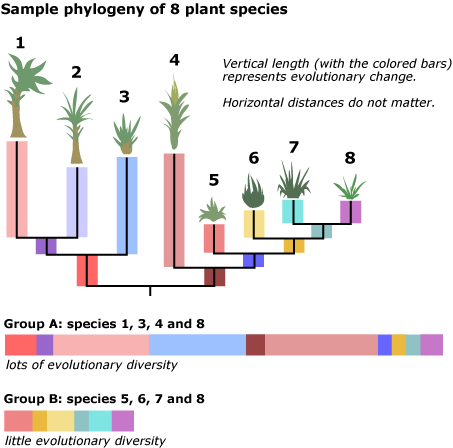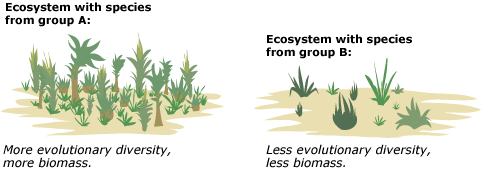
If your home were on fire, what would you take with you when you fled? The choice could be tough, with childhood toys, photo albums, and important documents all vying for attention. Unfortunately, we face a similarly difficult decision when it comes to conservation. Human activities may be triggering the Earth’s sixth mass extinction. Nearly 50% of all animal and plant species could disappear within our lifetime. As we race to staunch this rapid loss of biodiversity, we’ll need to make choices, but where should we concentrate our efforts? On the Siberian tiger, the world’s rarest plant, a chunk of Amazonian rain forest, or a threatened estuary that serves as a nursery for ocean life? Whatever we decide, we don’t have time to waste. The sooner we take action on species preservation, the more likely those efforts are to succeed. Now, new research suggests that evolutionary history can help us make some of these difficult decisions more easily.
Where's the evolution?
Many conservationists are interested in preserving functioning ecosystems — assemblies of plants, animals, and microorganisms in their native habitats that can sustain themselves — but this aim is not always easy to accomplish. Ecosystems are like immensely complex machines. Removing one key part could change how the whole thing works or even cause it to grind to a halt. Biologists have reasoned that plants are essential parts of these ecological machines since they form the base of most food webs, capturing the sun’s energy and converting it into forms that other species can use. But are some plants more important than others in the functioning of an ecosystem?
New research suggests that evolutionary history can help reveal which sets of plant species are most important in maintaining an ecosystem’s integrity. To understand this finding, it will help to first review some basic ecology. Many biologists study the role of plants in ecosystems by performing experiments. They vary the number and type of plant species in an experimental ecosystem (a greenhouse or test field) and then see how much biomass the ecosystem produces: does it turn into a lush jungle of vegetation or a relative desert, with fewer, scragglier plants? The results of these experiments suggest that more plant species means more biomass produced — and that is good news for the planet. More biomass translates into more plant mass providing food for animals, producing oxygen, and absorbing the greenhouse gas carbon dioxide.
This result is not so surprising. Corn, for example, rapidly depletes soil of the nutrients it most needs for growth. Without the regular application of fertilizer, fields planted with this single species will soon stop producing much at all. An equally sized patch of rainforest, on the other hand, requires no special supplements to produce abundant biomass year after year. That’s partly because the diversity of its inhabitants fill different niches: they each use slightly different sets of resources and may produce resources that other species can use, reinforcing the forest’s exuberant cycle of growth.
Researchers Marc Cadotte, Bradley Cardinale, and Todd Oakley thought that there might be more to learn from such ecological experiments. After all, we’d all agree that preserving more species is better — but it’s often not possible to preserve all the species in a habitat. The researchers wondered if particular sets of species were unusually good at keeping the ecosystem productive. They suspected that the evolutionary relationships among the ecosystem’s plants play a role in determining the amount of biomass produced. An ecosystem based on distantly related plants might be more productive than one based on closely related plants, they reasoned, since the distant relatives would be more likely to have evolved to occupy distinct niches.
To test this idea, the team needed a way to measure the closeness of the evolutionary relationships among a group of plants. This is commonly done with an evolutionary tree, or phylogeny, where the length of each branch is proportional to the amount of evolutionary change that occurred along that branch. Long branches mean lots of evolution. Short branches mean little change. By mapping a group of organisms onto one of these phylogenies and adding up the lengths of all the branches that connect them, we can get a handle on the evolutionary and genetic diversity of that group of organisms.
The researchers looked at 29 experiments that varied the species in an ecosystem. For each experiment, they mapped the plant species onto a phylogeny, calculated the branch lengths separating the species, and compared this to the amount of biomass the ecosystem produced. The result? Diversity makes a difference! Ecosystems with more diverse groups of plants (i.e., plants spanning more of the tree of life) tend to produce more biomass. In fact, branch length was a more reliable predictor of biomass than the number of species or ecological types (e.g., woody vs. grassy) in the ecosystem.
This finding suggests that, if we want to preserve functioning ecosystems, we should take special pains to save evolutionarily distant species. For example, if forced to choose, we may want to put our resources into protecting species like the buttercup, which occupies a longer branch on the tree of life than its grassland neighbors, sunflowers and daisies, which are closely related to one another. Another advantage of this new phylogenetic conservation strategy is that it is relatively easy to put into practice. Researchers have already constructed a fairly comprehensive plant phylogeny, and mapping an unfamiliar plant species’ location on the tree of life is not too difficult or costly. The ease is especially important as we race against time to preserve Earth’s fragile biodiversity. Almost half of the world’s plant species may be threatened with extinction — and while we probably can’t save all of them, we can do our best to protect those that are most important to the survival of the species around them.
Primary literature:
- Cadotte, M. W., Cardinale, B. J., and Oakley, T. H. (2008). Evolutionary history and the effect of biodiversity on plant productivity. Proceedings of the National Academy of Sciences USA 105(44):17012-17017. Read it »
- Pitman, N. C. A., and Jørgensen, P. M. (2002). Estimating the size of the world's threatened flora. Science 298(5595):989.
News articles:
- A short summary of the research from LiveScience
- A news article examining the implications of this study from the Santa Barbara Independent
- A press release thoroughly describing the research from the University of California, Santa Barbara
Understanding Evolution resources:
- A tutorial on understanding phylogenetic trees
- A reader on applications of evolutionary theory for conservation
- A research profile describing how past studying past mass extinctions may help us learn more about the current mass extinction
Background information from Understanding Global Change:
- This article describes a reason that we might want to preserve “evolutionarily distant” species. In your own words, explain what is meant by evolutionary distance.
- According to the new research described above, why is preserving evolutionarily distant species important?
- Why are conservationists interested in how much biomass an altered ecosystem produces?
- Study the illustrations of branch length in the article above. Is it possible for two species that are each others’ closest relatives to be separated by more evolutionary distance than two species that are not each other’s closest relatives? Explain your reasoning.
- This article describes one consideration that might be important as we decide how to focus our conservation efforts. Describe at least three other considerations that might be important in determining which species we should try to preserve.
- This article describes one way in which evolutionary theory may help us develop more effective conservation policies. Review other Evo in the News articles, and describe one other way in which evolutionary theory can inform our conservation efforts.
- Teach about phylogenetics: This web-based module for grades 6-12 introduces students to phylogenies, which depict the evolutionary relationships among groups of organisms.
- Teach about applications of phylogenetics: This short video for grades 9-12 introduces students to practical applications of phylogenetics.
- Cadotte, M. W., Cardinale, B. J., and Oakley, T. H. (2008). Evolutionary history and the effect of biodiversity on plant productivity. Proceedings of the National Academy of Sciences USA 105(44):17012-17017.
- Pitman, N. C. A., and Jørgensen, P. M. (2002). Estimating the size of the world's threatened flora. Science 298(5595):989.
- University of California, Santa Barbara. (2008, October 20). Current mass extinction spurs major study of which plants to save. Retrieved November 19, 2008 from the UCSB Public Affairs Office


